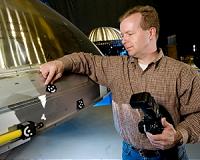 |
Kourou, French Guiana (SPX) May 18, 2010 The first Soyuz to be operated from the Spaceport as part of Arianespace's growing launcher family is ready for its next integration phase, which will involve mating of the Block I third stage with the vehicle's already-assembled first and second stages. This activity is being performed in the Spaceport's Soyuz Launcher Integration Building, which was constructed as part of the new launch base in French Guiana for this workhorse medium-lift Russian vehicle. In the first phase of the no. 1 Soyuz' integration, its four strap-on boosters were clustered around the vehicle's Block A core stage. Each of the strap-on boosters is powered by an RD-107A engine, which has four combustion chambers and nozzles, and operates on liquid oxygen and kerosene. Three-axis flight control is provided by aerofins and movable vernier thrusters. Soyuz' central core second stage is equipped with one RD-108A engine that has four combustion chambers and nozzles, along with vernier thrusters. The core stage's hammer-head shaped upper end accommodates the first stage boosters' integration around it. For the next phase of the no. 1 Soyuz' build-up at the Spaceport, the vehicle's Block I third stage will be integrated to the core stage. This stage utilizes an RD-0124 engine that replaces the launcher's previous standard third stage RD-0110 engine - significantly increasing the vehicle's overall performance. The third stage also carries the vehicle's avionics. A control system with digital computer and inertial measurement unit are used to give the Soyuz improved navigation accuracy and control capability. Soyuz launchers to be used from the Spaceport will be completed with the Fregat upper stage, which has been designed as an autonomous and flexible orbital vehicle. This flight-qualified stage extends the Soyuz launcher's capability to provide access to a full range of orbits, including medium-Earth orbit, Sun-synchronous orbit, geostationary transfer orbit and Earth escape trajectories. A Fregat functional model has been set up in the Spaceport's Soyuz Launcher Integration Building, and will be used in rehearsals for the preparation of this upper stage. The Soyuz configuration to be operated by Arianespace from the Spaceport is named the Soyuz 2-1a, and also is known by the Soyuz ST-A designation.
related report The launch "Service and Solutions" contract calls for the heavy-lift Ariane 5 ECA to place Intelsat 17 into geostationary transfer orbit at the end of 2010 from the European Space Port in French Guiana. With a mass of nearly 5800 kg. at liftoff, Intelsat 17 will provide higher-performing capacity across Europe, the Middle East, Russia and Asia from its orbital slot of 66 degrees East. This satellite will also expand Intelsat's C-band video distribution community in the Indian Ocean region. Intelsat 17 will replace the Intelsat 702 satellite. "We are proud to be able to offer Intelsat the unrivalled performance and reliability of the Ariane 5 ECA for its Intelsat 17 mission. We relish this opportunity to cultivate even further the longstanding relationship between Arianespace and Intelsat," said Arianespace Chairman and CEO Jean-Yves Le Gall. Intelsat is the world's leading provider of fixed satellite services. With Intelsat, advanced communications anywhere in the world are closer, by far.
Share This Article With Planet Earth
Related Links Arianespace Launch Pad at Space-Travel.com
 NASA Uses 'Polka Dots' For Precision Measurements
NASA Uses 'Polka Dots' For Precision MeasurementsWashington DC (SPX) May 17, 2010 What weighs 600 pounds, is shiny-silver with black and white polka dots and shaped like an upside-down saucer? If you guessed some sort of mod, fancy looking UFO, you are close. It's a fuel tank dome being developed for NASA's next-generation launch vehicles. But why polka dots? They are part of an engineering tool called photogrammetry, the practice of determining the geometric properties ... read more |
|
| The content herein, unless otherwise known to be public domain, are Copyright 1995-2010 - SpaceDaily. AFP and UPI Wire Stories are copyright Agence France-Presse and United Press International. ESA Portal Reports are copyright European Space Agency. All NASA sourced material is public domain. Additional copyrights may apply in whole or part to other bona fide parties. Advertising does not imply endorsement,agreement or approval of any opinions, statements or information provided by SpaceDaily on any Web page published or hosted by SpaceDaily. Privacy Statement |